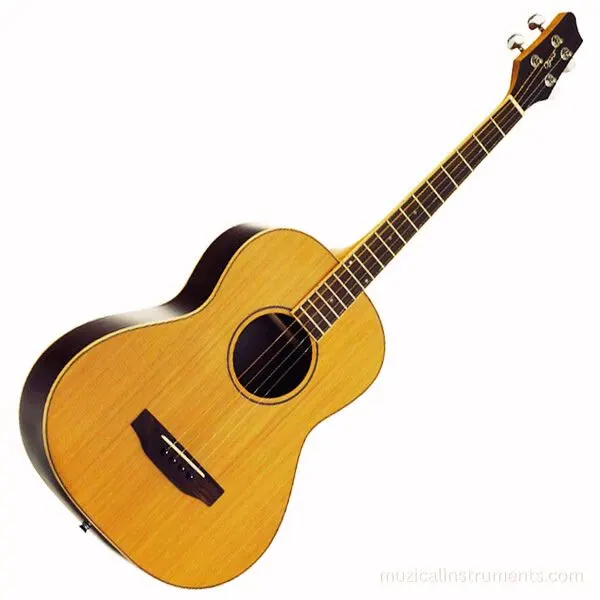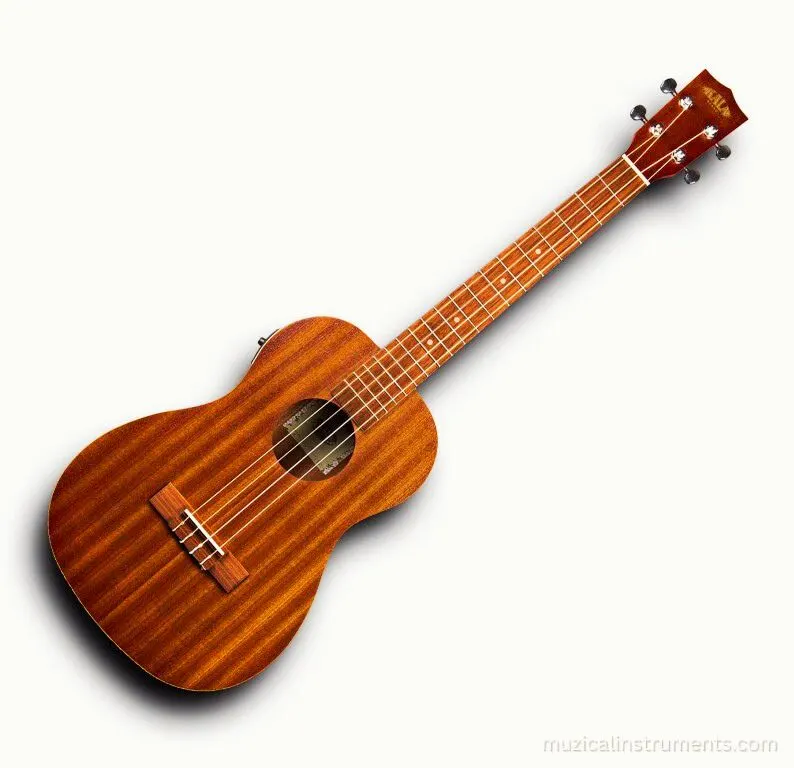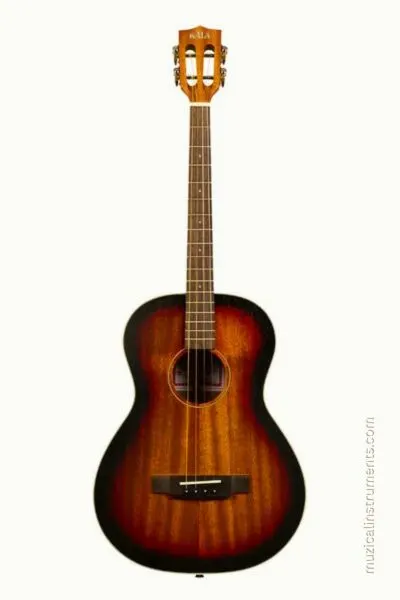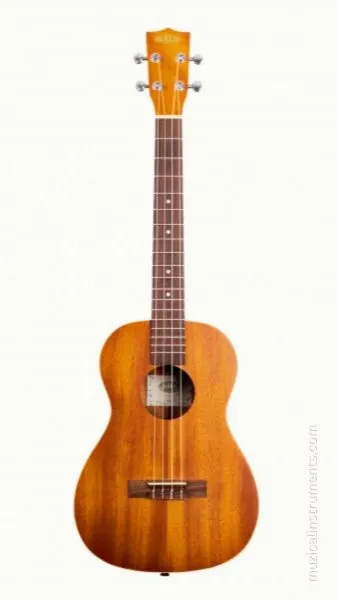Tenor Guitar vs Baritone Ukulele: A Surprising Tale of Two Four-Stringed Cousins
When comparing the tenor guitar vs baritone ukulele, you find two instruments that look like twins. Both have four strings. Both are smaller than regular guitars. So it’s easy to mix them up. But once you play them, you’ll see they’re very different.
This guide isn’t just about how they look. It’s about how they sound, where they come from, and how they feel in your hands. Whether you’re just getting started or you’re looking to try something new, knowing the real differences can help you choose the right one.
You’ll learn how each one is built, how they’re tuned, and what kind of music fits them best. By the end, you’ll know which one matches your style and sound and maybe even find your next favorite instrument.
Quick Look: Tenor Guitar vs Baritone Ukulele
| Feature | Tenor Guitar | Baritone Ukulele |
|---|---|---|
| Primary String Type | Steel Strings | Nylon Strings |
| Standard Tuning | C-G-D-A (Tuned in Fifths, like a viola) | D-G-B-E (Like the top 4 strings of a guitar) |
| Common Alt. Tunings | G-D-A-E (“Irish”), D-G-B-E (“Chicago”) | G-C-E-A (Requires different strings) |
| Overall Sound | Bright, loud, sharp, long sustain; metallic “zing” | Warm, mellow, soft, short sustain; gentle “thump” |
| Scale Length | Longer (Typically 21–23 inches) | Shorter (Typically 19–21 inches) |
| Body Construction | Heavier build, strong bracing for steel strings | Lighter build, delicate bracing for nylon strings |
| Neck Construction | Thicker neck with metal truss rod | Thinner neck, usually no truss rod |
| Nut Width | Generally narrower (like electric guitars) | Generally wider (like classical guitars) |
| Primary Genres | Jazz, Folk, Swing, Celtic, Country | Folk-Pop, Traditional Hawaiian, Acoustic Pop |
| Ease of Learning | Harder due to tough steel strings | Easier with soft nylon strings |
| Best For Guitarists | “Chicago” tuning (DGBE) is familiar | Identical tuning and shapes — easy switch |
| Historical Origin | 1920s USA — for banjo players in jazz bands | 1950s — as a larger ukulele option |
What’s the Real Difference in How They’re Built?
The core difference in the tenor guitar vs baritone ukulele debate comes down to their construction. Though they look similar, they are built very differently to handle specific types of strings, which creates their unique sound and feel.


The Tenor Guitar: Built for Steel
A tenor guitar is constructed to be strong and loud, just like a small acoustic guitar.
- Strings and Build: It uses high-tension steel strings for a bright, crisp sound. This requires a stronger body with reinforced internal wood supports (bracing) and a tough neck containing a metal truss rod to keep it from bending.
The Baritone Ukulele: Built for Nylon
The baritone ukulele is built with a lighter touch, staying true to its ukulele roots.
- Strings and Build: It uses soft, low-tension nylon strings for a warm, mellow tone. This allows for a lighter body and a simpler neck without a truss rod. Because it’s more delicate, you should never put steel strings on a standard baritone uke.
Scale Length and Feel
The scale length and the vibrating length of the string also affects how each instrument plays.
- A tenor guitar’s scale is longer (21-23 inches), spacing the frets further apart, similar to a standard guitar.
- A baritone ukulele’s scale is shorter (19-21 inches), making the frets closer together for a more compact and often more comfortable feel, especially for those with smaller hands.
Pro Tip: If you’re a guitar player used to steel strings and a thinner neck, the tenor guitar will feel very normal to you. But if you play ukulele or just like the feel of soft nylon strings, the baritone ukulele will be a much more comfortable fit.
Do They Sound and Tune Alike?
The biggest sonic difference in the tenor guitar vs baritone ukulele comparison comes from their tuning. This is where the two instruments truly show their different personalities.
The standard tuning for a baritone ukulele is D-G-B-E. If you play guitar, that should look familiar, it’s the exact same as the top four strings of a regular guitar.
This “guitar tuning” makes it a super easy instrument for guitar players to learn. All the chord shapes you know on guitar will work right away. This tuning gives the baritone uke a deep, warm sound that is great for playing along with singers. The sound is often called mellow and sweet, but it still has a little punch to it.


The tenor guitar has more tuning options with a long history. The most common and traditional tuning is C-G-D-A. This is called tuning “in fifths,” which just means there’s a wider jump in notes between the strings.
This creates a very open, ringing sound that’s great for both strumming chords and playing melodies that need to be heard clearly. It’s why jazz and folk players love it.
Another popular tuning is the “Irish” tuning, G-D-A-E, which is the same as a mandolin but one octave lower. This is perfect for playing the fast, lively melodies you hear in Celtic music. And for those who want it to feel like a guitar, you can use “Chicago” tuning, which is D-G-B-E the same as a baritone uke. Even with the same tuning, the tenor guitar’s steel strings will always give it a brighter, sharper sound than the baritone ukulele’s nylon strings.
| Feature | Tenor Guitar | Baritone Ukulele |
|---|---|---|
| Main String Type | Steel | Nylon |
| Standard Tuning | C-G-D-A (Tuned in Fifths) | D-G-B-E (Like a Guitar) |
| Common Alt. Tunings | G-D-A-E, D-G-B-E | G-C-E-A (needs new strings) |
| Overall Sound | Bright, loud, sharp, rings out long | Warm, soft, gentle, quieter |
| Used Mostly In | Jazz, Folk, Old-Time Country | Pop, Folk, Singer-Songwriter |
Which One Is Easier to Play for a Beginner?
When considering the tenor guitar vs baritone ukulele for a beginner, the question of which is “easier” really depends on your musical background and what feels comfortable to you.
Why the Baritone Ukulele Is Often Easier
For many players, the baritone ukulele offers a gentler start.
- Softer on the Fingers: Its nylon strings are much softer and require less pressure than steel strings, making it ideal for beginners who haven’t built up finger calluses.
- Familiar for Guitarists: It’s tuned just like the top four strings of a guitar (D-G-B-E). This means guitar players can use the chord shapes they already know, making the transition incredibly simple.
- Tons of Resources: Because of its guitar-like tuning, a massive library of online lessons, chord charts, and song tutorials for guitar can be used right away.
The Learning Curve of the Tenor Guitar
The tenor guitar presents a different set of challenges and advantages.
- The Physical Challenge: Its steel strings are tougher on the fingertips at first and demand more finger strength to play chords cleanly.
- An Advantage for Some: For those who play mandolin or violin, its standard C-G-D-A tuning will feel very familiar and intuitive.
- Fewer, but Growing Resources: While not as common as guitar lessons, there is a dedicated and growing community of players and learning resources, especially in folk and jazz music.
Expert Insight: Don’t let the steel strings scare you away from the tenor guitar if you love its sound. The finger pain goes away after a few weeks of regular practice. And don’t think the baritone ukulele is just a toy; its rich sound and easy playability make it a serious instrument that many professional musicians use.
Can I Use Them for the Same Types of Music?
When looking at musical styles in the tenor guitar vs baritone ukulele matchup, you’ll find that while both are versatile, their unique sounds and histories have led them to shine in different genres.
The tenor guitar was invented during the big band jazz era. It was made so that banjo players could switch to guitar without having to learn a completely new instrument.
Its bright, loud sound was perfect for being heard over loud instruments like trumpets and saxophones. This great rhythm sound has made it a favorite in early jazz, swing, and folk music.
You can hear it driving the rhythm in bands from the 1920s and 30s. Today, modern artists like Neko Case use it for its unique sound, which is somewhere between a six-string guitar and a mandolin.
The baritone ukulele, with its soft and warm voice, is very popular with singer-songwriters and in modern folk music. Its gentle tone is perfect for playing behind a singer, as it adds a nice harmony without being too loud or distracting.
Since it’s tuned like a guitar, it’s easy to play popular songs, making it a great choice for playing at coffee shops or for acoustic recordings.
While you can play jazz on it, the nylon strings don’t have the same sharp “attack” as a tenor guitar’s steel strings, which is often preferred for that style. However, amazing players like James Hill have shown that you can play very complex and beautiful music on a baritone ukulele.
| Musical Use | Tenor Guitar | Baritone Ukulele |
|---|---|---|
| Playing Rhythm | Excellent (Bright and cuts through) | Good (Warm and blends in) |
| Playing Melodies | Excellent (Notes are clear and sharp) | Very Good (Notes are smooth and pretty) |
| Singer-Songwriter | Good (Gives a unique sound) | Excellent (Perfect for singing with) |
| Jazz | Very Common in older jazz | Not as common, but growing |
| Folk Music | Very Common (Especially Irish) | Common (Especially modern folk) |
In the end, what instrument you use is all up to you and your creativity. A tenor guitar can sound beautiful playing a soft song, and a baritone ukulele can sound great playing an upbeat folk tune. The trick is to know your instrument’s natural voice and use it to make your music sound its best.
Final Thoughts: Tenor Guitar vs Baritone Ukulele Which Is Your Perfect Match?
Our journey comparing the tenor guitar vs baritone ukulele shows two instruments that look alike but give you very different ways to make music.
The tenor guitar, with its bright-sounding steel strings, is great for playing powerful rhythms and clear melodies. It asks a little more from your fingertips but gives you a special sound you can’t get anywhere else.
The baritone ukulele, on the other hand, is all about warmth and comfort. Its soft nylon strings and guitar-like tuning make it a friendly instrument for beginners and an easy switch for guitarists, offering a lovely, mellow sound for more personal music.
Your choice should come down to the sound you love and the music you dream of playing.
- Do you want the bright, sharp sound of steel strings?
- Or do you prefer the soft, warm sound of nylon?
The best way to decide is to try them both. Go to a music store, borrow one from a friend, or watch videos online to hear the difference for yourself. No matter which one you pick, you’ll be adding a fun and amazing four-stringed friend to your musical life.
If you’re diving deeper into the ukulele world, this soprano vs concert ukulele guide can help you compare other popular sizes with ease.
Frequently Asked Questions: Tenor Guitar vs Baritone Ukulele
1. Can I put steel strings on my baritone ukulele?
It is strongly recommended that you do not put steel strings on a standard baritone ukulele. Baritone ukes are built with light internal bracing designed for the low tension of nylon strings. The high tension of steel strings can warp the neck, pull the bridge off, and potentially cause the top of the instrument to bulge or crack.
2. Can I use tenor guitar chords on a baritone ukulele?
It depends on the tuning. If the tenor guitar is tuned to “Chicago Tuning” (D-G-B-E), then yes, the chord shapes are identical to a standard-tuned baritone ukulele. However, if the tenor guitar is in its traditional C-G-D-A tuning, the chord shapes will be completely different and will not work on a baritone ukulele.
3. Which one is better for a singer-songwriter?
While both can be excellent choices, many singer-songwriters lean towards the baritone ukulele. Its warm, mellow, nylon-string sound provides a beautiful harmonic base that blends smoothly with the human voice without overpowering it. A tenor guitar can also work, offering a more unique, bright, and punchy accompaniment that can help a performer stand out.
4. Is a tenor guitar just a 4-string guitar?
While it is technically a guitar with four strings, its traditional tuning (C-G-D-A, in fifths) makes it a very different instrument from a standard 6-string guitar. This tuning gives it a wider sonic range and a more open, resonant voice. It is more accurately described as a cousin to the mandolin or viola family than simply a guitar with two fewer strings.
5. Do I need to use a pick to play?
Not necessarily, as it depends on the instrument and desired sound.
Tenor Guitar: Using a flatpick is very common, especially for playing chords and rhythm in jazz and folk music, as it brings out the brightness of the steel strings.
Baritone Ukulele: Fingerstyle or strumming with the thumb/fingers is more common. This technique complements the warm, soft tone of the nylon strings. However, using a felt or soft rubber pick can also produce a pleasant sound.
6. Which instrument is louder?
The tenor guitar is significantly louder than a baritone ukulele. Its steel strings and stronger body construction are designed to produce more volume, projection, and sustain, allowing it to be heard more easily in a group or band setting.
